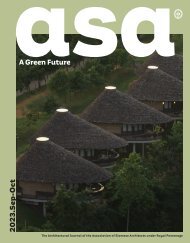ASA Journal 16/2023
Create successful ePaper yourself
Turn your PDF publications into a flip-book with our unique Google optimized e-Paper software.
BRICK: AS A BUILDING MATERIAL<br />
117<br />
เมื่อมีการค้นพบปูนปลาสเตอร์ที่ฉาบภายนอกอาคาร อิฐจึงถูกลดความ<br />
สำาคัญลงไป และได้รับการรื้อฟื้นให้เป็นที่นิยมขึ้นมาอีกครั้งหนึ่งใน<br />
ศตวรรษที่ 18 เมื่อมีการนำาอิฐมาก่อเป็นลวดลายต่าง ๆ ประดับอาคาร<br />
ในประเทศอังกฤษยุควิกตอเรียนอิฐสีแดงจะถูกกำ าหนดให้ใช้ที่ผนังภายนอก<br />
ของอาคารเพื่อให้มองเห็นชัดท่ามกลางหมอกหนา เป็นการช่วยแก้ปัญหา<br />
จราจรในเมือง<br />
ในยุคปฏิวัติอุตสาหกรรม ประมาณกลางศตวรรษที่ 19 เหตุผลที่อิฐได้รับ<br />
ความนิยมในช่วงเวลานี้เกิดจากเทคนิคที่ก้าวหน้าขึ้น ทำาให้สามารถผลิต<br />
อิฐได้ครั้งละเป็นจำานวนมาก เนื่องจากการพัฒนาเตาเผาและแม่พิมพ์<br />
ในการหล่อขึ้นรูป การใช้อิฐก่อสร้างจึงทั้งเร็วขึ้นและประหยัดขึ้น แม้กระทั่ง<br />
ในพื้นที่ที่อุดมไปด้วยหิน อิฐ และไม้ก็ยังเป็นวัสดุที่ถูกนำามาใช้งานมาก<br />
ที่สุด แม้กระทั่งในช่วงที่การก่อสร้างเกิดขึ้นอย่างมากมาย แผ่ขยายไปถึง<br />
ทวีปอเมริกา<br />
สถาปนิกยุคโมเดิร์นที่บูชาอิฐและนำ ามาสร้างสรรค์ในงานสถาปัตยกรรมได้<br />
อย่างวิเศษ เช่น Le Corbusier, Louise I. Kahn และ Frank Lloyd Wright<br />
ผลงานการออกแบบของท่านที่มีอิฐเป็นตัวเอกนั้น ได้สร้างสีสันและ<br />
ความงามอันคลาสสิคให้แก่สิ่งแวดล้อมที่งานเหล่านั้นตั้งอยู่ ให้เป็นเกียรติ<br />
แก่ชุมชนและเมืองที่ครอบครองอย่างน่าภาคภูมิใจมาจนถึงทุกวันนี้<br />
อิิฐจัาก่เติา<br />
อิฐที่ใช้ในการก่อสร้างและตกแต่งอาคารปัจจุบันส่วนใหญ่ทำ าด้วยดินเหนียว<br />
และมีส่วนประกอบเป็นทรายหรือแกลบ แคลเชียมซิลิเกตและส่วนผสม<br />
อื่น ๆ เพื่อให้อิฐมีลักษณะทางกายภาพที่หลากหลายสำาหรับการใช้งาน<br />
แต่ละประเภทที่แตกต่างกัน เมื่อนำาส่วนผสมทั้งหมดผสมเข้าด้วยกัน<br />
แล้วจึงนำาไปลงในแม่พิมพ์เพื่อขึ้นรูป แล้วนำ าไปเผาในเตาเผาที่ตั้งอุณหภูมิ<br />
เฉพาะสำาหรับแต่ละประเภทของดิน สาเหตุเพราะดินแต่ละประเภทจะมี<br />
จุดหลอมตัว สุกตัว ในอุณหภูมิที่แตกต่างกัน เมื่อเผาสุกแล้วก็จะได้อิฐที่<br />
ผลิตได้จำานวนหนึ่งพร้อมที่จะนำาไปใช้ในงานก่อสร้างต่อไป<br />
สีของอิฐที่ได้จากการเผาจะเป็นผลจากเคมีและแร่ธาตุที่อยู่ในวัตถุดิบที่<br />
ใช้ในการผลิต อุณหภูมิในการเผา และตำาแหน่งภายในเตาเผา ตัวอย่าง<br />
เช่น สีน้ำาตาลดำาเป็นผลจากแร่เหล็กที่มีอยู่มากในเนื้อดิน สีขาวหรือเหลือง<br />
จะมีส่วนผสมของแคลเซียมคาร์บอเนตอย่างเข้มข้น อิฐทั่วไปจะเผาแล้ว<br />
ได้สีแดงหรือส้มอิฐ แต่ก็จะมีเฉดสีที่แตกต่างกัน ถ้าอุณหภูมิสูงขึ้น<br />
จะทำาให้อิฐมีสีแดงเข้มขึ้น แล้วไปม่วง น้ำาตาล ไปจนถึงดำาเมื่อเผาใน<br />
อุณหภูมิที่สูงมาก ๆ<br />
บางครั้งชื่อที่ใช้เรียกชนิดของอิฐสะท้อนถึงสีและต้นกำาเนิดของวัตถุดิบ<br />
หรือแหล่งผลิตได้ เช่น Red London Stock Brick หรือ Cambridge White<br />
แม้กระทั่งในประเทศไทย ดินเหนียวที่นำ ามาผลิตเป็นอิฐมาจากแหล่งต่าง ๆ<br />
ทั่วประเทศก็อาจจะให้สีและเนื้อดินไม่เหมือนกัน ขึ้นอยู่กับแร่ธาตุที่มี<br />
อยู่ในบริเวณนั้น ๆ เช่น อิฐจากอ่างทองจะมีสีแดง มีเนื้อเหนียวและจะมี<br />
ความแกร่งเมื่อเผา ดินจากลำาปางจะมีสีขาว เป็นต้น<br />
It was revitalized and popularized in the 18 th century when<br />
bricks were used to make numerous designs to embellish<br />
buildings. Red bricks were designated for use on the external<br />
walls of buildings in Victorian England to help solve traffic<br />
difficulties in the city by allowing clear visibility amid dense fog.<br />
Brick became popular again during the Industrial Revolution, in<br />
the middle of the nineteenth century, as technology advanced,<br />
producing a vast number of bricks at once. Because of the<br />
advancement of kilns and casting molds, employing bricks for<br />
construction is now faster and more cost-effective. Brick and<br />
wood are the most widely used materials, even in locations<br />
rich in stone. It then spread to the American continent, even<br />
during periods of significant development.<br />
Le Corbusier, Louise I. Kahn, and Frank Lloyd Wright are<br />
examples of modernist master architects who embraced bricks<br />
and used them to build beautiful architecture masterpieces.<br />
Their designs, which used bricks as the main protagonist,<br />
added a classic color and beauty to the surroundings in which<br />
they were placed to commemorate the towns and cities they<br />
proudly occupy today.<br />
Bricks from the Kiln<br />
Bricks used in building construction and decorating today are<br />
generally constructed of clay and incorporate sand or rice<br />
husks, calcium silicate, and other substances to give bricks<br />
a variety of physical properties for various applications. When<br />
all ingredients have been combined, they are placed in a mold<br />
to be molded. It is then burned in a kiln at a temperature<br />
tailored to each soil type. This is because each soil type has<br />
different melting and ripening points at different temperatures.<br />
A number of bricks will be created after firing, suitable for<br />
construction activity.<br />
The color of fired bricks is determined by the chemicals and<br />
minerals in the raw materials used in production, the burning<br />
temperature, and the kiln site. The brownish-black color, for<br />
example, is caused by the clay’s high iron content. The colors<br />
white and yellow include a significant percentage of calcium<br />
carbonate. Generally, red or orange bricks are burned. It will,<br />
however, have various colors. When fired at extremely high<br />
temperatures, the bricks will be darker red, purple, brown,<br />
and black.<br />
The color and provenance of the raw material or production<br />
area are sometimes reflected in the name of a type of brick,<br />
such as Red London Stock Brick or Cambridge White. Even<br />
in Thailand, the clay used to make bricks is sourced from<br />
various locations throughout the country and may vary in<br />
color and texture. It is determined by the minerals present in<br />
the environment. Bricks from Ang Thong, for example, will be<br />
red. It has a rough texture and will remain tough after firing.<br />
Lampang soil, for example, will be white.

















